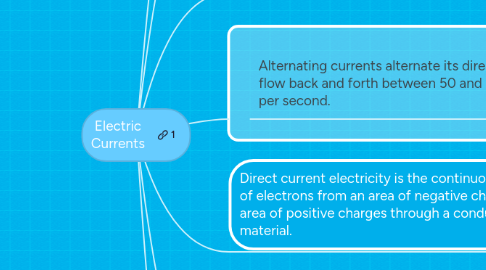
1. Ohms Law is the mathematical relation between voltage, resistance and current - best comparison is water flowing through pipes
1.1. To find voltage: Current * Resistance
1.1.1. Voltage is measured in Volts (V) (Lazoen)
1.2. To find current: Voltage/Resistance
1.2.1. Current is measured in Amps (I) (Lazoen)
1.3. To find resistance: Voltage/Current
1.3.1. Resistance is measured in Ohms (R) (Lazoen)
2. Ohm's Law states that the electric current passing through a conductor is directly proportional to the potential difference across the conductor.
2.1. Voltage=Current*Resistance
2.1.1. Examples: 6V/2ohms=3A
2.2. The law was formulated in 1827 by German physicist Georg Ohm while he was doing experiments based on metals conductivity to electricity.
2.2.1. Georg Ohm, a German scientist, discovered this principle while experimenting with the conductivity of metals. (EB)
3. Direct current electricity is the continuous movement of electrons from an area of negative charges to an area of positive charges through a conducting material.
3.1. An example of this type of electrical current would be a flashlight and a cell phone.
3.2. DC circuits are used to allows the electrons to flow, similar to water. The circuit has source of electrical energy, like a battery, and a conducting wire that runs from the positive to the negative end. (Lazoen)
4. Alternating currents alternate its direction of flow back and forth between 50 and 60 times per second.
4.1. An Example of a AC would be televisions, lights and computers.
4.1.1. AC electricity is more commonly used in homes because the voltage can be change which allows for the electricity to travel farther and to be safer for homes since the voltage can be reduced.
5. Direct current electricity is the continuous movement of electrons from an area of negative charges to an area of positive charges through a conducting material.
6. Charges in electric currents flow when you attract or repel them. Voltage is the amount of attraction or repulsion.
6.1. Voltage = Potential Difference
6.2. 1 Volt = 1 Joule/Coulumb
6.3. V = W/Q (Voltage = Amount of Energy/Charge)
6.4. Current moves in the direction that a positive charge would move. The charge carriers of the current are negative, but we define them as moving in the direction of a positive charge. (EB)
6.4.1. The reason that we define current as moving in the direction of a positive charge is because scientists used to believe that was how the current flowed before they were able to study it further.
6.5. Electrons within a circuit, move incredibly slowly, because of the collisions with fixed atoms that they experience. The typical speed of a current’s drift is around 1 meter per hour. (EB)
6.5.1. An ammeter is used to measure electrical current. It does this by measure the time between the electrons hitting it.
